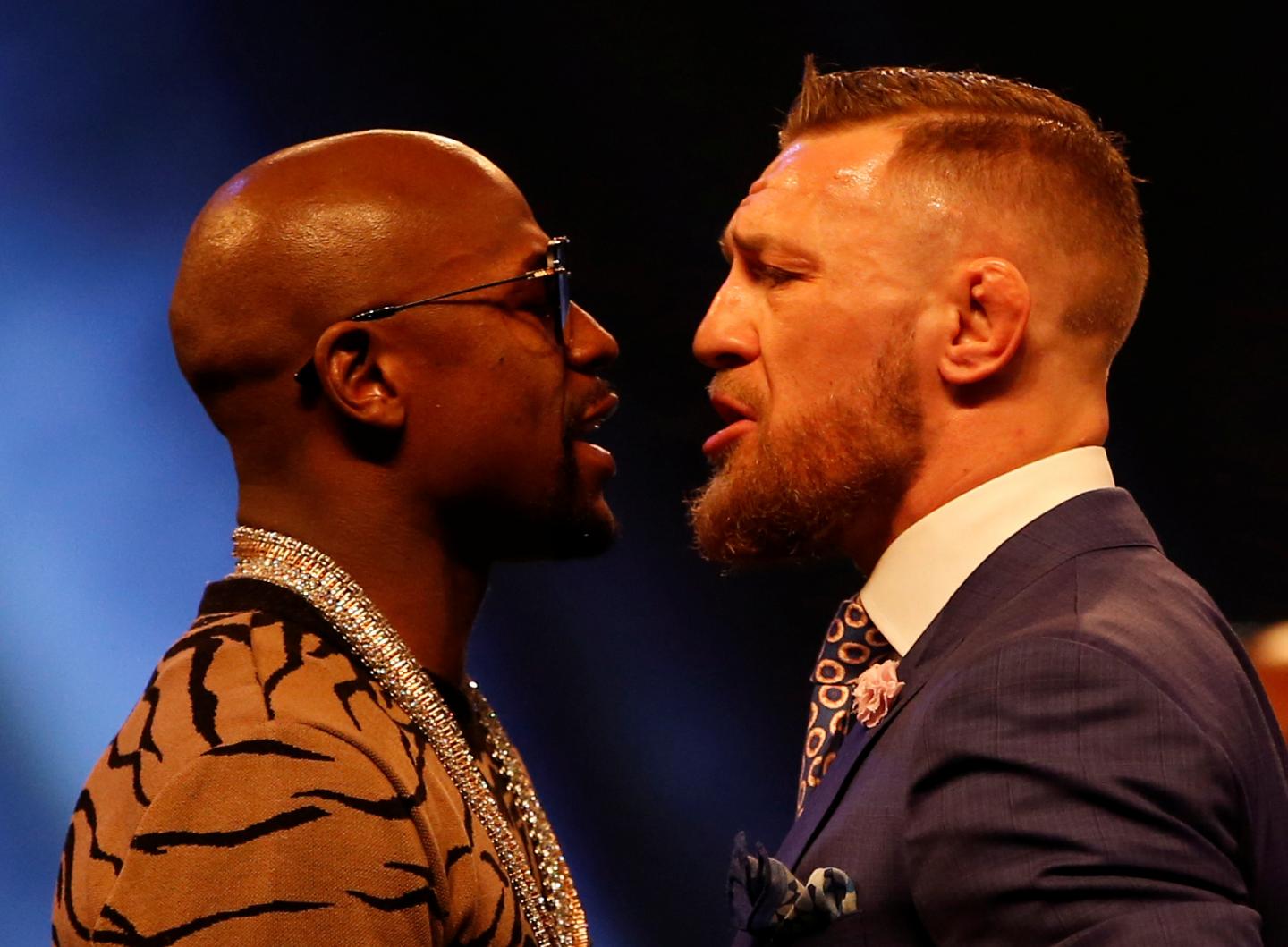
Fix, farce, fraud, fake, fiasco. There is a whole lexicon of F-words that could be added to the original four letter expletive employed so liberally by the combatants during the build-up to this weekend’s fistic vaudeville in Las Vegas.
During the next few days, we will be knee-deep in more ribald rhetoric and gobby garbage plus an extra large dose of Sky-perbole as Floyd Mayweather Jnr and Conor McGregor go about their mouthy business of promoting their impending cross-over contest, unchastened by the opprobrium which greeted their recent crass ticket-selling circus.
We are told that the bullshine-wrapped blockbuster in Las Vegas’ T-Mobile Arena between the undefeated 40-year-old former multi-belt world boxing champion and the garrulous Ultimate Fighting Championship icon, supposedly under Queensberry Rules, is the most bizarre encounter in the history of unarmed combat, if not sport itself.
Not so. Not by a distance in my opinion.
Leaving aside Muhammad Ali’s joke “fight” with the Japanese wrestler Anthony Inoki, surely it is the mythical match-up between “The Greatest” and the original Rocky – Marciano that is – which remains untouchable as the most bizarre happening in boxing.
By a strange coincidence the M&M treat between Mayweather and McGregor on Saturday (August 26) occurs five days before the anniversary of the death of the “Brockton Blockbuster” Marciano, who was killed when the light aircraft in which he was a passenger crashed near Iowa 48-years-ago.
Ironically, it is Marciano’s famed record of 49 contests without defeat which Mayweather will exceed should he overcome McGregor, which course he will if there is any semblance of reality about their scheduled 12 rounds of manufactured mayhem for which each will earn at least $100 million.
Marciano died at 45, just a few weeks after climbing into ring in Miami with Ali, then a fellow ex-world heavyweight champion 28 years his junior.

They were there to complete the filming of the computerized contest between the two.
Yes, Marciano and Ali really did fight, although the choreographed punches were pulled and the blood was tomato ketchup, just as in the real Rocky franchise movies.
The celluloid contest came about in July 1969 when Ali, then in fistic exile over his Vietnam War draft refusal, filed a lawsuit against a radio station advertising executive named Murray Woroner, claiming damages for alleged defamation.
The two settled the case when Ali, short of readies and options, agreed to collaborate with Woroner in making a filmed simulation of a bout with the long-retired Marciano. Both boxers were paid £10,000.
By the time Rocky faced Ali, he had not fought for 14 years. He was 45, balding, and had a bad back and a short temper.
Marciano lost over 50lb in preparing for the fight and wore a jet black toupee to in order to look as he did in his prime. At 5ft 10in and a few pounds over 13 stones, Marciano was the smallest heavyweight champion in history, but with a wrecking ball of a right hand famously dubbed his “Suzy Q”.
So, in July 1969, stubby Marciano and the 6ft 3in Ali stepped into a gymnasium ring with blacked-out walls on the north side of Miami and boxed 70 one-minute rounds, supposedly guided by computers into which the opinionated data of 250 boxing experts had been fed.
Several and different endings knockdowns were filmed with the fighters and film-makers sworn to secrecy.
Having been told to avoid head punches, they mostly labored around the tapping each other, though Marciano did attempt to pummel the rope-a-doping Ali’s body.
At one point, Ali unleashed a solid left jab which sent Marciano’s hairpiece skidding across the ring. “I thought it was a dead cat flying through the air,” Ali’s trainer Angelo Dundee quipped later. Marciano angrily insisted the incident should be cut from the film.
The final outcome would not be revealed until the release of the film on January 20, 1970, shown in 1,500 theaters in the USA, Canada and throughout Europe, grossing around $2.5 million.
American and Canadian audiences were shown a version where the computer had determined that Marciano would have knocked Ali out in the 13th round while European audiences were shown another ending in which Ali was depicted the winner also by a 13th round knock-out
When Ali was shown the US version he joked: “That computer must have been made in Alabama.”
Throughout filming, a respectull Ali, who never seriously dissed or denigrated a white opponent in his entire career, referred to Marciano as “Champ”. And in his autobiography, he wrote “Rocky was quiet, peaceful, humble, not cocky or boastful”, adding that he “deserves his place as one of the greatest of the great heavyweights”.
He claimed Marciano was better than Joe Frazier. Marciano, meanwhile, called Ali “the fastest man on wheels”. The pair parted on good terms.
A month later, Marciano was dead when the three-seat plane he was travelling in from Chicago to Des Moines crashed into an oak tree in the middle of a cornfield on the eve of his 46th birthday.
He never saw the film, but just a few days after its completion, he visited London and was entertained to lunch by Boxing Writers Club.
I sat opposite him in the Ye Olde Cheshire Cheese pub just off Fleet Street and while the film’s producers had warned both him and Ali not to reveal either ending, after a good few glasses of his favorite Chianti, Marciano quietly admitted: “I would never have beaten Ali at his best in a real fight. I knew that when we both stepped into that ring.
“He was too big, too quick and knew how to use the ropes to his advantage.
“He had the fastest hands I’ve ever seen.”
Although this fantasy fight was what Donald Trump would call “fake news”, it was fascinating nonetheless.
And actually, it may have prove to have been more realistic than the pugilistic pantomime which is about to engulf us.
By Alan Hubbard
Republished with permission from insidethegames.biz.